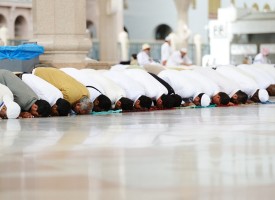This year’s Hajj has seen one of the worst tragedies to ever hit the annual congregation that we Muslims make.
First, there was the crane incident, where a construction crane collapsed on praying Muslims in the Grand mosque itself, killing around a 100 people and injuring many more.
Then there was the horrendous stampede at Mina, just meters away from the Jamarat, where pilgrims throw stones in remembrance of Prophet Ibrahim’s (AS) act of doing so. Officials state that the stampede killed around 1,200 people and injured more than a 900 (if you believe the unofficial reports the figures are much higher).
The media is filled with reports of various countries blaming each other for the disaster. Whoever is to blame, the fact still remains that there are hundreds of Muslims dead and their families suffering.
This has happened before
The worst part about this tragedy is that it is not the first time that this has happened. Stampede, fires, construction collapse, etc. all have happened before. Below is a list of some of the major tragedies that have taken place at Hajj over the past 30 years.
Ghaza Hotel collapse
In 2006, the Ghaza hotel situated near the grand mosque of Makkah collapsed. The hotel was accommodating Hajj pilgrims at the time and the collapse killed 76 and injured 64 people.
Stampedes
There have been quite a few stampedes during the Hajj pilgrimage, generally due to panic, suffocation, etc.
- During the Hajj of 1990, there was a stampede inside a tunnel from Makkah to Mina. The tunnel was choked with pilgrims and the stampede lead to the deaths of 1,426 pilgrims. This was the worst disaster to have ever hit the pilgrimage.
- In 1994, another stampede broke out. This time during the stoning of the Jamarat. The stampede ended up claiming the lives of 270 pilgrims.
- Another stampede broke out at the 1998 Hajj, this time again during the stoning of the Jamarat ritual. The stampede took place at the Jamarat bridge and killed 118 pilgrims while injuring 180.
- Jamarat was the venue of another stampede in 2001, where 35 pilgrims were trampled during the stoning of the Jamarat.
- The stoning of the Jamarat took another 14 lives in 2003 due to a stampede
- A major stampede again took place during the same ritual in 2004. This one consumed the lives of 251 pilgrims and injured another 244.
- In 2006, the Jamarat ritual claimed another 289 lives and injured 289 more as a sudden rush at the Jamarat led to people tripping and triggering a deadly stampede.
Fires
- During the Hajj that took place in the winter of 1975, a gas cylinder exploded and resulted in the deaths of 200 pilgrims.
- 343 pilgrims died in 1997 and 1,500 were injured when a fire broke out in Mina’s tent city where the pilgrims stay during the Hajj.
Plane Crashes
- On January 22, 1973, 176 Hajis were killed when a Royal Jordanian flight crashed in Nigeria. The crash took the lives of 176 pilgrims that were returning from Makkah after performing Hajj.
- Another flight carrying Hajis crashed on December 4, 1974. A Martin air flight crashed in Sri Lanka and killed 191 people on board it.
- In a similar incident, an Icelandic Airline flight crashed near Colombo in Sri Lanka on November 15, 1978 and killed 170 pilgrims returning from the Hajj.
- 1979 saw another flight, this time a PIA flight, crash soon after takeoff at the Jeddah international airport. It was 26th November and the crash killed 156 passengers on board.
- Another crash on July 11, 1991 killed 247 Hajis. The airline was Nigeria Airways, flying from Jeddah to Sokoto in Nigeria. It too crashed just after takeoff from Jeddah Airport. In addition to the Hajis the 14 crew members also died.
In addition to the above, there have been a few disease epidemics, riots and several other incidents that have taken the lives of Hajis.
I think in closing, it is very important to point out that the Hajj is the largest annual gathering of people in the world. This year there were 2 million people that performed the pilgrimage. As one can appreciate, managing such a huge gathering of people, all from different nationalities and speaking hundreds of different languages, is an enormous task. The facilities available to Hajis today are much, much better than they were just 20 years ago and they are continually being improved in order to make this once in a lifetime experience more comfortable and safer for all the pilgrims who arrive.
I pray for all the hajis that passed away in these incidents during the pilgrimage and hope that all future Hajj are safe and free of any untoward incidents… Ameen!
image credit: wikimedia








No comments!
There are no comments yet, but you can be first to comment this article.